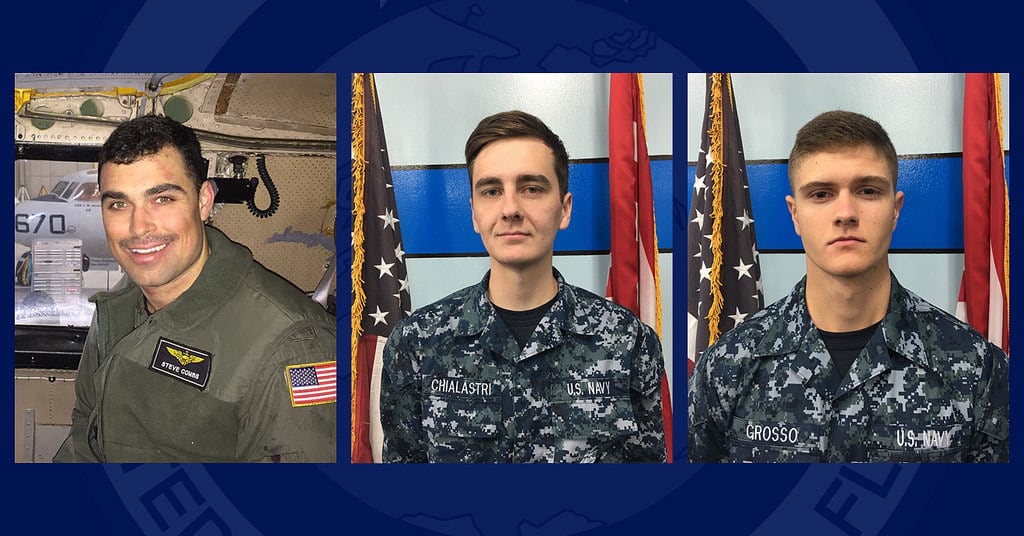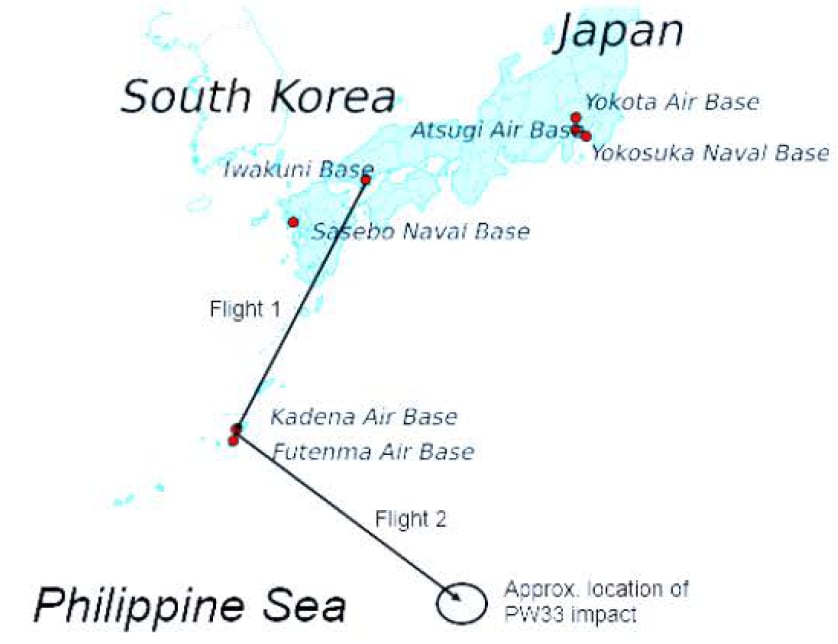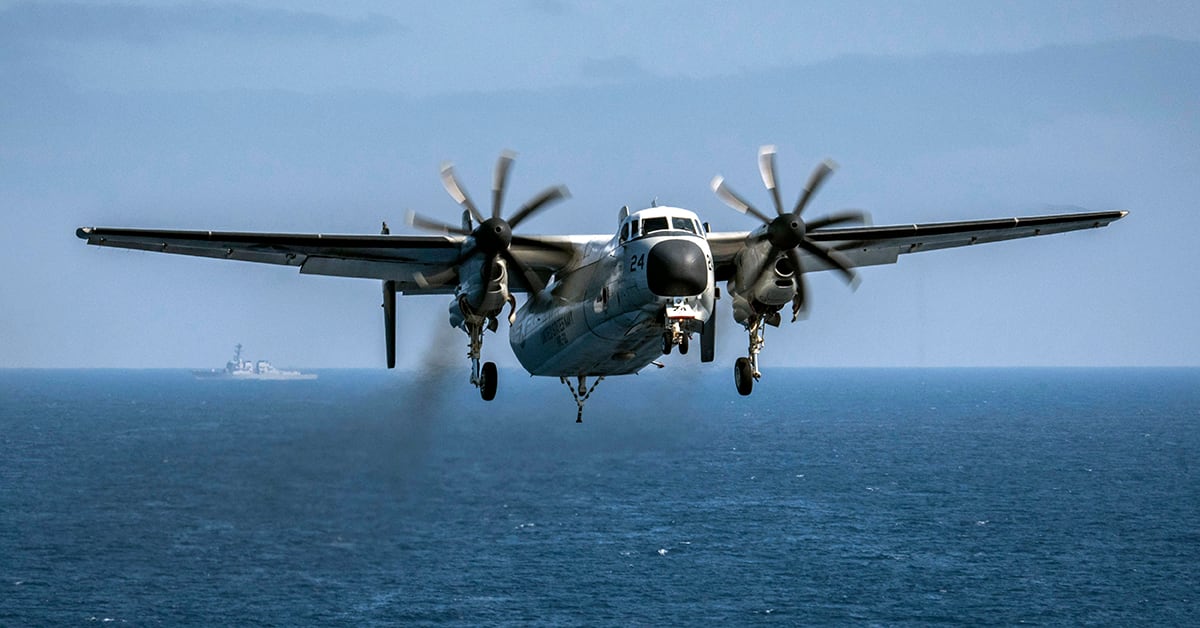Before it crashed on the afternoon of Nov. 22, 2017, a Navy C-2A Greyhound flying under the callsign “Password 33” enjoyed clear weather as it traveled from Marine Corps Air Station Iwakuni, Japan, to the aircraft carrier Ronald Reagan.
But when it was about 15 nautical miles out from the carrier, the four crew members and seven passengers heard “a sudden loud bang.”
Just 101 seconds later, Password 33 hit the Philippine Sea going roughly 126 mph, killing one pilot and two junior sailors on board, according to a copy of the command investigation obtained by Navy Times.
Lt. Steven Combs, Aviation Boatswain’s Mate (Equipment) Airman Matthew Chialastri, and Aviation Ordnance Airman Apprentice Bryan Grosso all perished once the plane struck the water, the result of a dual-engine failure.
Still, efforts by Combs and the air commander pilot to execute a rarely used emergency “ditching” procedure, coupled with the aircrew’s ability to open the top escape hatches amidst the chaos, prevented a much worse outcome.
“Despite the tragedy and loss of three Sailors, the crew of PW 33 should be commended for their efforts that enabled eight Sailors to survive the mishap,” the investigating officer wrote.

‘PASSWORD 33 IS GOING INTO THE WATER’
Seconds after the bang was aboard Password 33, “the aircraft immediately began to shake violently and a ‘foggy,’ acrid smelling smoke entered the cockpit and cabin,” the investigation states.
The left propeller’s spinner, a bulb-like attachment to the prop’s front that moves air toward the blades and helps cool the system, had broken off.
“There was excessive vibration felt throughout the aircraft, but initially there were no caution lights, fire lights, or visible damage observed on either engine from the cockpit,” the investigator wrote.
The shaking became so intense that the pilots couldn’t read their instruments. Combs and the main pilot surmised that the left engine was causing the problem, so they decided to cut fuel to that side.
But the violent vibrations continued and a right engine warning light illuminated.
“The aircraft commander determined that the right engine was failing and rapidly losing torque,” the investigator wrote.
The commander then attempted to “airstart” the left engine and get Password 33 to the Reagan on one prop, but to no avail.
“Given their low altitude at the time of the emergency, and the extreme vibrations that made the engine instruments almost impossible to read, the pilot and co-pilot had limited time and minimal information available to assess the cause of the emergency and respond,” the investigator wrote.
A minute after the bang, the plane radioed an emergency and “dual engine failure” to Reagan’s tower.
“Password 33 is going into the water,” they reported.
The other pilot ordered Combs to pull back on the yoke and increase altitude so he could troubleshoot the issue, but the plane never got higher than 1,500 feet, according to the report.
Combs and the other pilot, whose name is redacted in the investigation copy released to Navy Times, soon realized they’d have to attempt a ditching maneuver into the water, a drastic emergency measure that no pilots had attempted since the 1970s.
“Although practiced routinely throughout training, the last known C-2A ditch was conducted over 40 years ago and a ditch is considered an extremely challenging and dangerous maneuver,” the investigator wrote.
In the frantic seconds before impact, crew members were able to pop several ditch hatches on the plane’s top.
The main pilot feathered the left prop to create minimal drag before he and Combs pulled on the yokes to keep the plane steady as it neared the water.

Password 33 cleared a swell and hit the sea, leaving no time to set up a “best-ditch scenario.”
The surviving pilot said he had never felt such “immediate and violent” shaking upon impact and believes “Lt. Combs never took his hands off the yoke because he was trying to maintain control of the aircraft.”
The plane filled with water in a matter of seconds, preventing the crew from deploying a life raft.
A petty officer on board couldn’t recall seeing the water rising in the aircraft, the report states, “just water being there suddenly.”
“One reported that it quickly went dark in the cabin from all the water and another stated that before he had time to take a breath, the water had covered his head.”
Another passenger unhooked their harness and had to swim around a blockage to reach the hatch in the ceiling, while one crew member gasped in a cabin air pocket before swimming to safety. One sailor could remember nothing between the crash and reaching the surface.
No one who escaped Password 33 recalled seeing Combs, Chialastri or Grosso after the crash.
Chialastri and Grosso had been seated in the first row of the main cabin toward the cargo and the cockpit, according to the investigation.
‘THE WHOLE PLANE HAS SUNK’
Survivors reported that the plane was tilted nose-down in the water, with only the tail visible, within 30 seconds of impact.
Bobbing in the middle of the sea, the aircraft commander pilot’s flotation device didn’t inflate. He called out to a crew member, who swam over from 30 yards away, according to the investigation.
“The aircraft commander and the assisting crew member attempted to inflate a life raft in a nearby seat pan that had come loose from the cockpit,” the report states. “When that did not work, they swam to and huddled with the two passengers, helping keep the aircraft commander afloat.”
Another crew member grouped the three other passengers together and reassured them that they were very close to the Reagan and would be rescued soon.
By 2:45 p.m., less than four minutes after the loud bang on Password 33, another Greyhound reported to the tower that “the whole plane has sunk.”
The investigator praised the pilots and aircrew for actions that saved most of those onboard.
“Three minutes and 49 seconds elapsed from the first airborne indications of a problem until PW 33 was completely submerged in the open ocean,” the investigator wrote.
“During this short period of time the aircrew prepared the passengers for impact, affected a ditch, and enabled the egress of eight of the eleven personnel onboard. Their actions are a testament to their training and courage and are worthy of recognition.”
Because he had no gear, the aircraft commander was the first to be pulled up into a rescue helicopter, followed by a senior chief “who was panicking” and a “very calm” junior sailor.
The survivors were on the flattop in less than an hour.
Search and rescue operations to find Chialastri, Combs and Grosso were called off 43 hours after the crash.
The two aircrewmen each received the Navy and Marine Corps Medal, which is awarded for heroic acts outside of conflict.
Combs has been put in for the Distinguished Flying Cross. His co-pilot has been nominated for an Air Medal as well.
‘COMPOUND EMERGENCIES’
After the crash, Password 33 sank 18,500 feet before coming to rest on the sea floor. Raising the Greyhound required a massive salvage effort that did not return the wreckage to the surface until May 2019.
The Navy determined that the crash was caused by both engines failing, a horrific sequence that began when the spinner came off the left propeller, according to the investigation. The right engine also failed in those frenzied minutes, although the investigation states that engineering analyses could not determine the precise engine failure sequence.
A similar mishap occurred with another Greyhound’s prop spinner a few months later, in May 2018, over southern California, but the pilots were able to land.
Both mishaps prompted the Navy to revise and update its checklist and maintenance procedures.

“After the engineering analysis was conducted and working in concert with (Naval Air Systems Command), new (Naval Air Training and Operating Procedures) specific to spinner out of balance (wobble) were officially released,” Naval Air Forces spokesman Cmdr. Ronald Flanders said in an email this week.
“In addition, checklist items require aircrew to visually inspect for spinner integrity and a maintenance event was added that inspect the spinner hardware security.”
Recovering and analyzing the wreckage led to a delay in answers and little closure for the families of the lost sailors. Navy Times provided a copy of the investigation to the sailors’ families — the Navy had not notified them that the investigation was complete or shared a copy.
Combs’ sister, Elizabeth Combs, said this week that it has been about a year since any Navy personnel have been in contact regarding the crash investigation.
Still, she said, her brother’s community has kept them apprised of ongoing developments.
“The informal channels have been wonderful,” Combs said. “The formal channels have been, for lack of a better term, (expletive).”
Combs confirmed that the Navy recovered her brother’s remains but declined to speak for the other families.
Grosso’s father declined to comment, and Navy Times could not reach Chialastri’s family.
Combs said she had shared the report with them.
The investigation states that Password 33 was up to date on maintenance at the time of its crash and had enjoyed “a very strong maintenance program that was assessed as safe for flight with scores at or above fleet average.”
Still, engineering probes of the recovered engines “painted a grim narrative of the severity of the compound emergencies that downed the aircraft,” the investigator wrote.
In addition to the left propeller spinner coming off, a loose side mount plagued the right prop, but it remains unclear whether that loose part was a contributing factor in the mishap, the investigator wrote.
The root causes for why the left prop spinner failed and why the right engine mount came loose — human or material failing — “could not be determined through the post-salvage (engineering investigation),” the report states.
“It is possible the port propeller imbalance combined with a loose side mount on (the right) engine contributed to the failure,” the report states.
The investigation found no evidence warranting disciplinary action against Password 33’s aircrew or maintenance personnel.
In his endorsement of the investigation Naval Air Forces Commander Vice Adm. DeWolfe Miller directed that aviation commands brief the mishap, study sink rates for Greyhounds and further assess the challenges of low-altitude engine malfunctions.
Among other prescriptions, Miller also mandated that air commands implement a life preserver maintenance review and “continue to stress the importance of diligence in this area.”
Geoff is the managing editor of Military Times, but he still loves writing stories. He covered Iraq and Afghanistan extensively and was a reporter at the Chicago Tribune. He welcomes any and all kinds of tips at geoffz@militarytimes.com.





